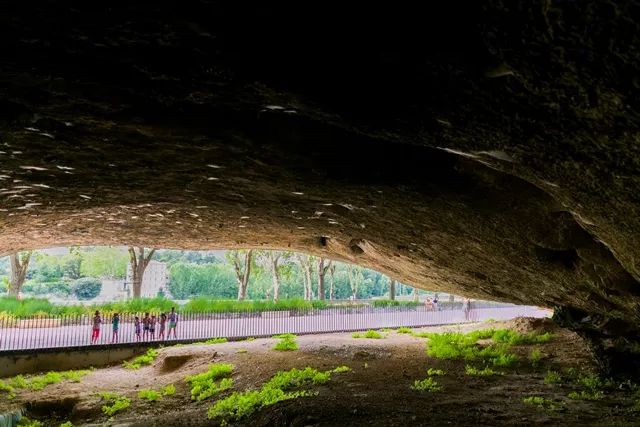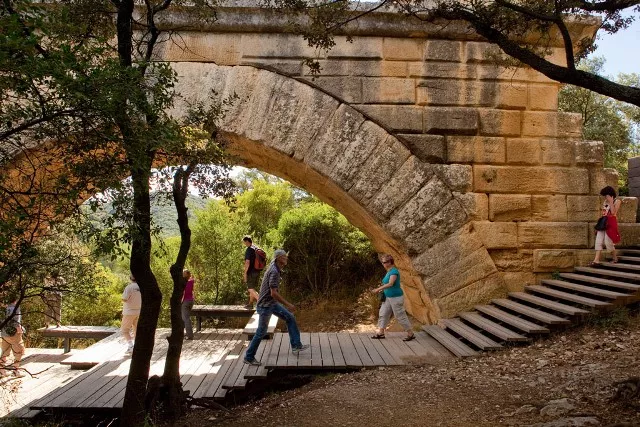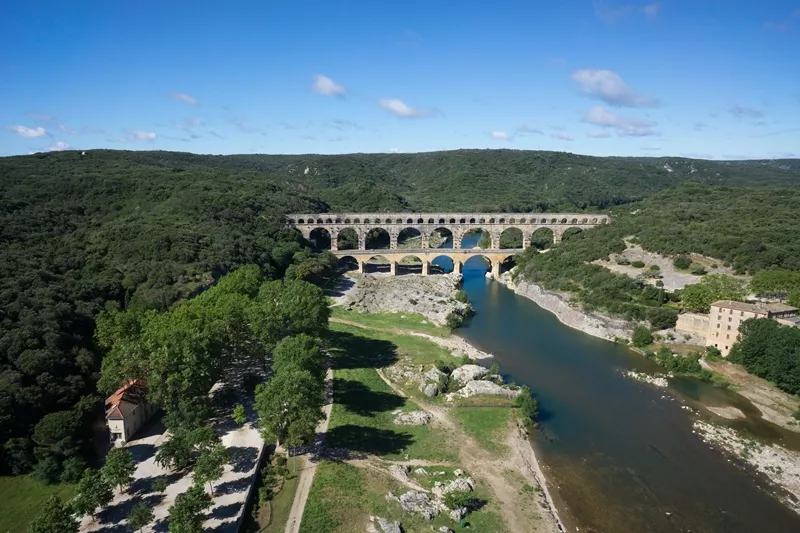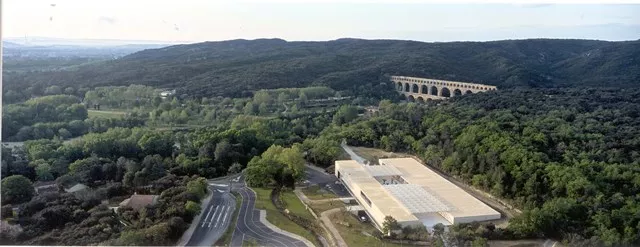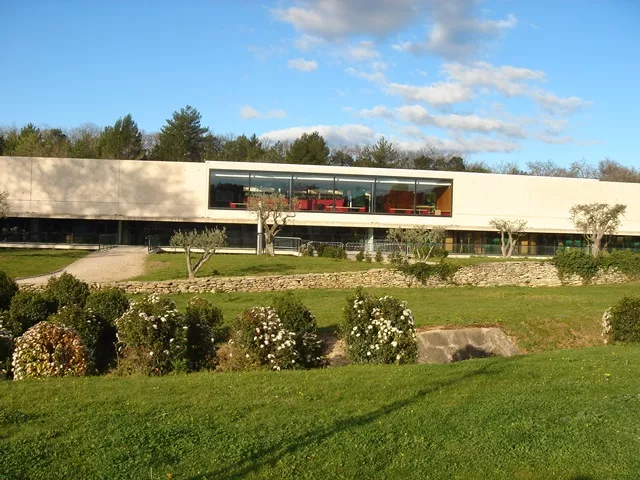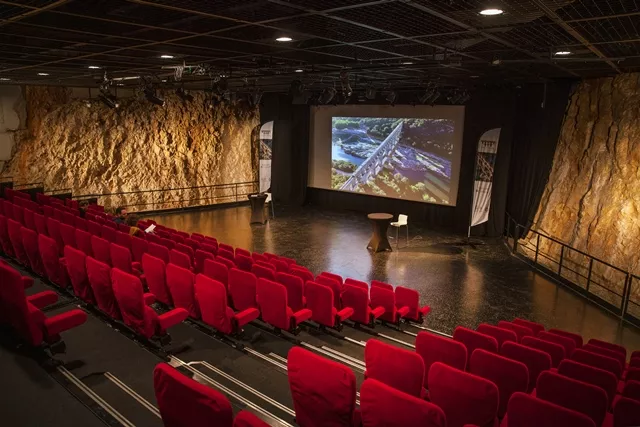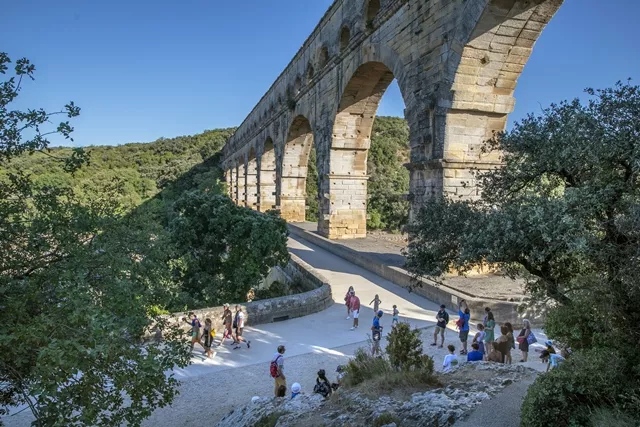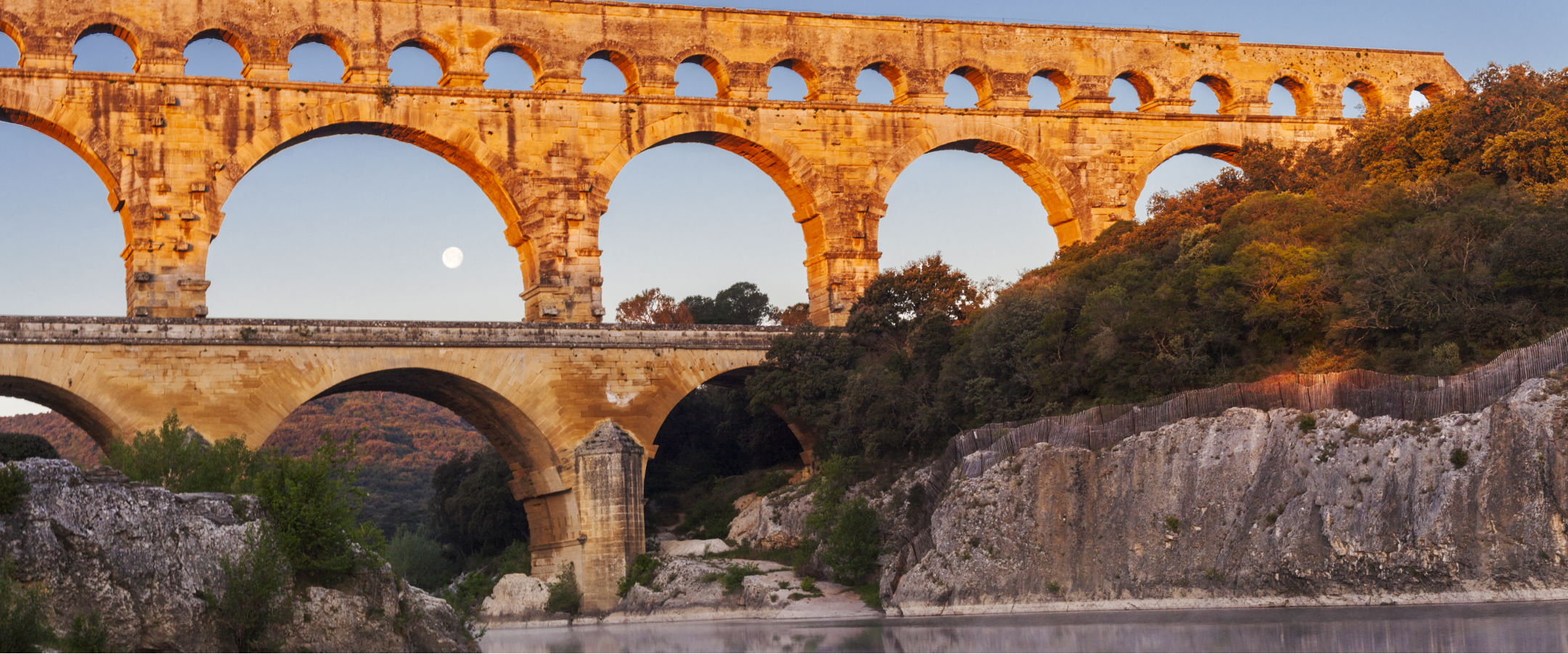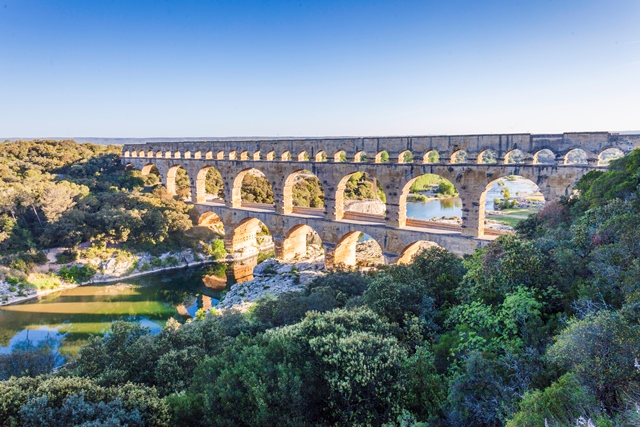40 centuries of history
Best known for its Roman aqueduct, the Pont de Gard actually has a much older history. Archaeology takes us back in time to discover its prehistoric past.
Built around 50 AD, under the reigns of Claudius or Nero, the aqueduct to which the Pont du Gard belongs supplied the city of Nîmes with large quantities of pressurised water for 5 centuries. The Roman city of Nîmes, the ancient ‘Nemausus’, grew so rapidly in the 1st century that it decided to equip itself with an aqueduct, following in the footsteps of Rome, the capital and model for the entire Roman Empire. With an average gradient of 25 cm per kilometre, one of the lowest ever achieved at the time, the aqueduct carried 30,000 to 40,000 m3 of running water per day by gravity from a spring in Uzès, over a distance of 50 kilometres to Nîmes.
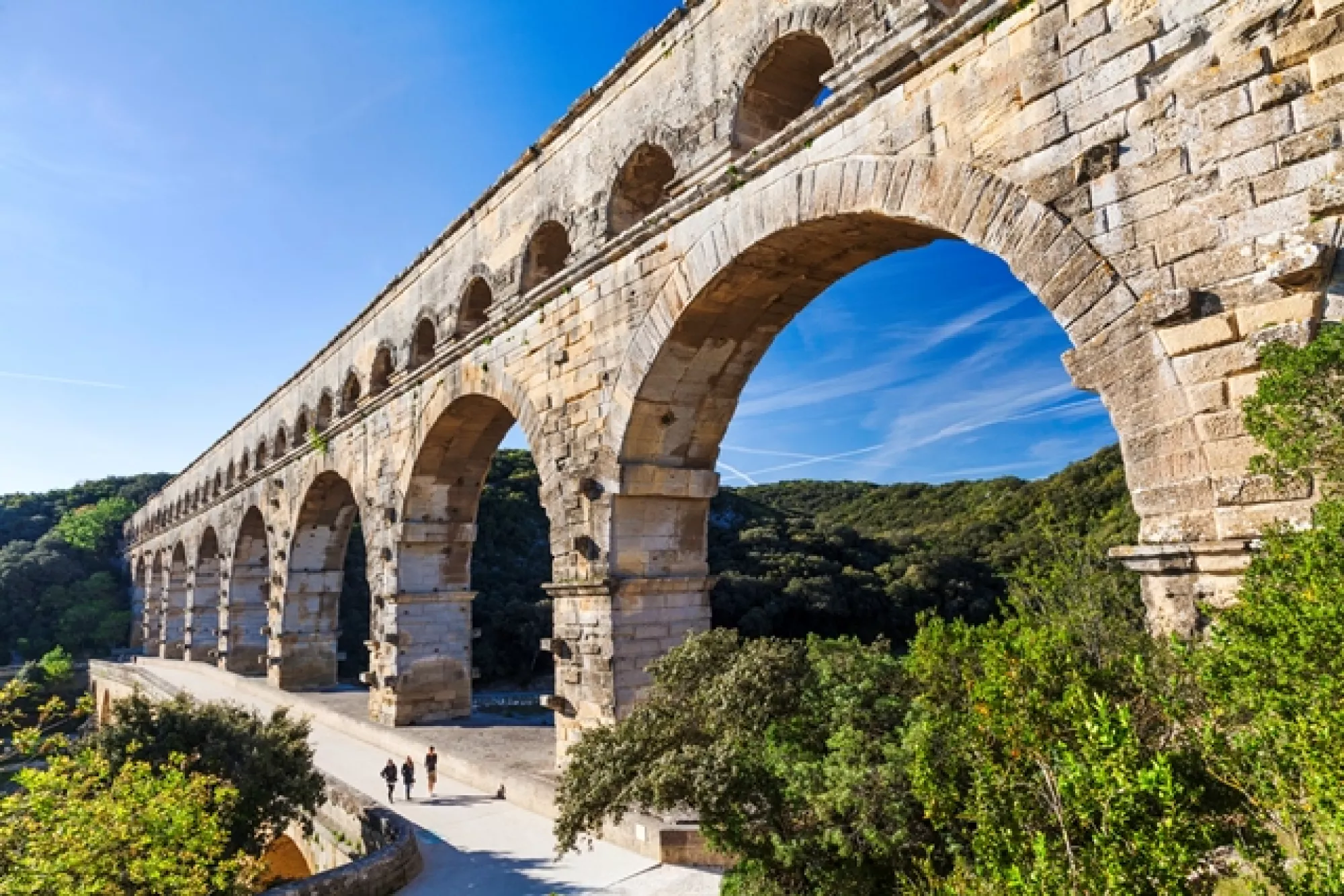
At 49 metres high, the Pont du Gard is the highest Roman aqueduct bridge in the world.
It is the only example of an ancient 3-storey bridge still standing today. Nearly a thousand men worked on this colossal project, which took just 5 years to complete.
Centuries of use
At the beginning of the 6th century, when the region was dominated by the Franks and the Visigoths, the Pont du Gard was finally abandoned and its structures came to be used as quarries for building materials. From the Middle Ages onwards the monument fulfilled many different functions with little to do with its original design it a source of inspiration for many Renaissance artists.
The first twelve arches of the third level were taken to build several churches and buildings in the surrounding area. The bridge's upper passage, which was wider and more dangerous, was condemned.
It was at this time that the first mention of the Pont du Gard appeared in the form of ‘Pons de Gartio’. It appears in a document dated 1295 concerning a toll that the King of France, Philippe le Bel, granted to the Lord of Uzès in exchange for the barony of Lunel.
At the time, the road leading to Beaucaire and its famous fair passed through the Pont du Gard. Traffic was increasing sharply at this time, which is why it was necessary to create a better passage for carts and animals at the middle level of the monument. Access ramps were built and the piers on the second level were further indented (on the west side). However, this effervescence posed a real danger to the structure, which could have collapsed.
It should be noted that the builders of the Pont d'Avignon and the Pont-Saint-Esprit were greatly inspired by the Pont du Gard.
Winter 1429-1430: Following a high water level in the Gardon during the winter, King Charles VII is said to have ordered the States of Languedoc ‘to work without delay to repair this extremely damaged building’. A certain awareness of the need to conserve the monument began to emerge around this time.
In 1565: Charles de l'Ecluse's map is the oldest official document to mention the Pont du Gard, as ‘an admirable bridge, the work of the Romans, once an aqueduct’.
It was customary for the Compagnons du Tour de France to come and salute and be inspired by this feat of Roman architecture. To leave a trace of their passage, they engraved their marks and tools.
More than 320 companion marks have been found on the building. The oldest mark dates back to 1611 and the most recent to 1989. Today, no-one carves their name into the stone.
From 1696 to 1702: under the direction of the architects Daviler and de Laurens, major restoration work was carried out to repair the damage caused by cart traffic and the excavation of the piers: corbelling and filling in the indentations. Awareness of the need to conserve the Pont du Gard was growing, and the great architects of the day took a growing interest.
Between 1743 and 1747: the States of Languedoc ordered the construction of a road bridge alongside the aqueduct bridge. Henri Pitot (Pitot tube and Montpellier aqueduct) was the engineer in charge of the project. To mark the occasion, the Estel quarry was reopened to carry out this large-scale project.
Discover or download the story of Henri Pitot: the man, the engineer and his inventions (1695-1771) by Michel Desbordes, Professor at Polytech'Montpellier, and Michel Lescure, Director of Modernisation and Development of the Road Network, Conseil Général du Gard.
https://www.pontdugard.fr/sites/default/files//documents/conference_pitot.pdf
In 1840, Prosper Mérimée, the 1st Inspector of Historic Monuments, noted the sad state of the Pont du Gard: "The great arches are in a terrible state, a number of keystones are detached and all are gnawed in such a way as to give great cause for concern. The rapporteur thinks that this is a matter that should be dealt with without wasting any time, as the administration would be unforgivable if an accident were to occur.
Mérimée had the Pont du Gard included on the first list of Historic Monuments. This step accelerated the process of preserving the Pont du Gard.
Between 1842 and 1846, two restoration campaigns were carried out to save the monument from its state of disrepair. Charles Questel, the architect in charge of monuments in Nîmes and the Pont du Gard, carried out the work. A spiral staircase was built at the same time.
Between 1844 and 1845: engineers considered reusing the aqueduct to supply Nîmes and its textile industries.
From 1855 to 1859: a second restoration campaign was carried out by the architect Jean-Charles Laisné.
Around 1865: a coaching inn was built on the first railway line to be established in the Gard.
From 1936: the upheavals linked to tourism accelerated. The passage of vehicles over the road bridge caused vibrations that threatened to topple the structure. To avoid this catastrophe, 310 tonnes of cement were injected into the sensitive areas.
In 1959, a campsite was built on the right bank of the river, marking the beginning of an exploitation that showed little respect for the monument and its environment.
In 1985, the Pont du Gard was listed as a Unesco World Heritage Site, and plans for a cultural facility on the site began to be studied.
From 1986 onwards, the General Council carried out studies into the development of the site. A defence committee was set up.
1988 saw the creation of a scientific council. Its aim was to guide the designers of development projects.
1998: the Pont du Gard development project was adopted (Declaration of Public Utility), putting an end to the anarchy and degradation of the site.
In 2000, the site was opened to the public, and the exhibition areas were opened in 2001.
2003: the Pont du Gard became an EPCC (Etablissement Public de Coopération Culturelle).
2004: the Pont du Gard was awarded the Grand Site de France label. This means that the ancient monument and its natural environment can be preserved and showcased to a certain extent.
In 2015: the EPCC adopted a five-year restoration plan to protect the remains of the aqueduct.
With 1,500,000 visitors, it is now France's most visited ancient monument.
1985 marked the year in which the Pont du Gard was officially listed as a UNESCO World Heritage Site. Although this designation testifies to the monument's exceptional universal value, the Département du Gard, anticipating a major new influx of tourists, took the decision to protect and develop the Gard's most visited cultural and tourist site.
